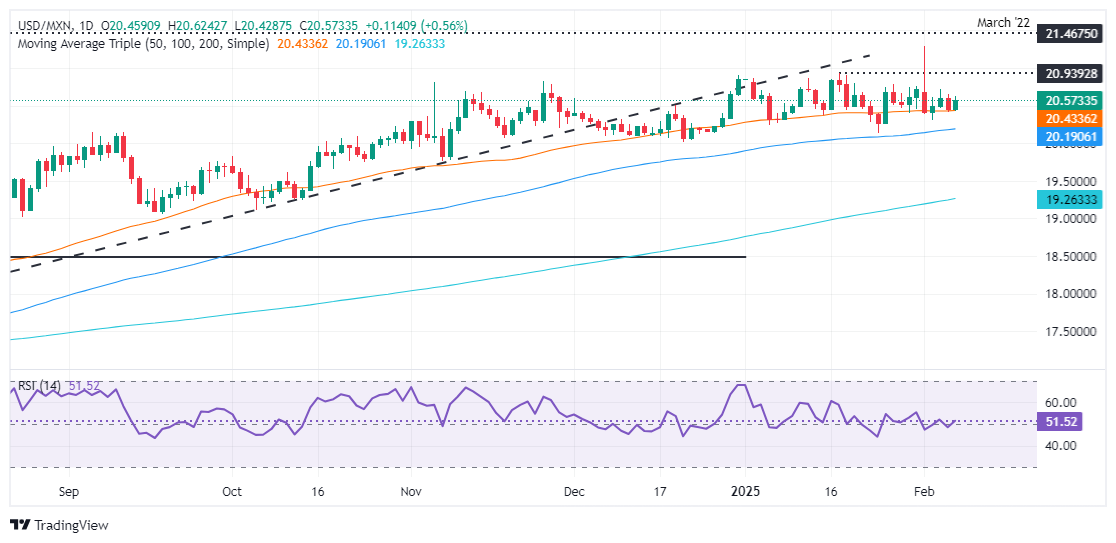Mexican Peso slides as inflation dips, justifying Banxico’s rate cut
- Mexican Peso treads water as inflation figures hint at further easing by Banxico.
- Despite US payrolls falling short, a lower unemployment rate boosts the USD against the Peso.
- Interest rate forecasts suggest further easing in Mexico, with the Fed maintaining a cautious outlook for 2025.
The Mexican Peso (MXN) reversed its course and depreciated against the Greenback on Friday after inflation data in Mexico justified the 50 basis points interest rate cut by Banco de Mexico (Banxico) on Thursday. In the United States (US), job data was mixed, as payrolls missed the mark but the Unemployment Rate edged lower. The USD/MXN trades at 20.60, up 0.86%.
Inflation in Mexico edged lower in January, exceeding estimates revealed by the Instituto Nacional de Estadistica Geografia e Informatica (INEGI). Headline and core inflation remained within the Banxico 3% plus or minus 1% range, and improved compared to the latest report, opening the door for further easing by the Mexican central bank.
On Thursday, Banxico lowered borrowing costs from 10% to 9.50% and hinted that it could lower rates by the same magnitude in further meetings. Banxico’s officials added that inflation would converge to 3% in the third quarter of 2026.
The USD/MXN pair extended its gains after the release of the last US Nonfarm Payrolls report. Although the figures came short of expectations, an improvement in the Unemployment Rate spurred a leg-up in the exotic pair.
Furthermore, the interest rate differential between Mexico and the US will narrow. Banxico is expected to drop the primary reference rate to 8.50%, according to the cCentral bBank’s latest private economist poll. Conversely, the Federal Reserve (Fed) paused its easing cycle and projected two rate cuts in 2025, as revealed by last December’s Summary of Economic Projections (SEP).
Daily digest market movers: Progress on Mexican inflation, weighs on Mexican Peso
- Mexico's Consumer Price Index (CPI) for January increased by 3.53% YoY, down from 4.21% the previous month and beneath estimates of 3.61%. Core CPI rose by 3.66% YoY, up from 3.65%, but below forecasts of 3.70%.
- The evolution of the disinflation process in Mexico and last quarter's economic contraction of -0.6% QoQ were the main drivers of Banxico’s 50 bps reduction in borrowing costs.
- Banxico’s decision was not unanimous, as Deputy Governor Jonathan Heath voted for a 25-bps cut. Currently, the board is split between four doves, and Heath is the only “hawk.”
- US Nonfarm Payrolls in January dipped from 256K to 143K, missing the mark of 170K. The Unemployment Rate slid from 4.1% to 4%.
- Trade disputes between the US and Mexico remain in the boiler room. Although countries found common ground, USD/MXN traders should know that there is a 30-day pause and that tensions could arise throughout the end of February.
- Money market fed funds rate futures are pricing in 39 basis points (bps) of easing by the Federal Reserve in 2025.
USD/MXN technical outlook: Mexican Peso poised for further losses
USD/MXN has consolidated within the 20.30 – 20.70 area for the last four days, following Monday’s volatile session due to Trump’s tariffs on Mexico. The pair remains upward biased, with strong support at the 50-day Simple Moving average (SMA) at 20.57.
If USD/MXN rises past 20.70, the next resistance would be the January 17 daily peak at 20.90 before testing 21.00 and the year-to-date (YTD) high at 21.29.
Conversely, if USD/MXN drops below the 50-day SMA, the next support would be the 100-day SMA at 20.22. Once cleared, further downside is seen, and the pair could challenge 20.00.

Mexican Peso FAQs
The Mexican Peso (MXN) is the most traded currency among its Latin American peers. Its value is broadly determined by the performance of the Mexican economy, the country’s central bank’s policy, the amount of foreign investment in the country and even the levels of remittances sent by Mexicans who live abroad, particularly in the United States. Geopolitical trends can also move MXN: for example, the process of nearshoring – or the decision by some firms to relocate manufacturing capacity and supply chains closer to their home countries – is also seen as a catalyst for the Mexican currency as the country is considered a key manufacturing hub in the American continent. Another catalyst for MXN is Oil prices as Mexico is a key exporter of the commodity.
The main objective of Mexico’s central bank, also known as Banxico, is to maintain inflation at low and stable levels (at or close to its target of 3%, the midpoint in a tolerance band of between 2% and 4%). To this end, the bank sets an appropriate level of interest rates. When inflation is too high, Banxico will attempt to tame it by raising interest rates, making it more expensive for households and businesses to borrow money, thus cooling demand and the overall economy. Higher interest rates are generally positive for the Mexican Peso (MXN) as they lead to higher yields, making the country a more attractive place for investors. On the contrary, lower interest rates tend to weaken MXN.
Macroeconomic data releases are key to assess the state of the economy and can have an impact on the Mexican Peso (MXN) valuation. A strong Mexican economy, based on high economic growth, low unemployment and high confidence is good for MXN. Not only does it attract more foreign investment but it may encourage the Bank of Mexico (Banxico) to increase interest rates, particularly if this strength comes together with elevated inflation. However, if economic data is weak, MXN is likely to depreciate.
As an emerging-market currency, the Mexican Peso (MXN) tends to strive during risk-on periods, or when investors perceive that broader market risks are low and thus are eager to engage with investments that carry a higher risk. Conversely, MXN tends to weaken at times of market turbulence or economic uncertainty as investors tend to sell higher-risk assets and flee to the more-stable safe havens.

